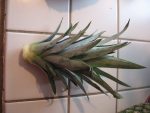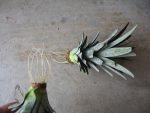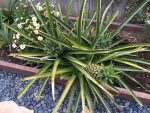In post-Columbian Europe, imported or greenhouse pineapples were a symbol of wealth, often being used for decoration rather than being eaten. Now, imagine a world gone crazy, where even the canned pineapple is only a memory. For those of us who are well-stocked and even have a garden, the loss of trucking and worldwide shipping means a lot of fruits, especially tropical ones, will be simply a memory, kind of like how generations ago received oranges at Christmas as treats. Citrus fruits are not too much of a stretch in parts of the U.S., but pineapples will be rare. What is a fresh pineapple, something otherwise impossible to get, going to be worth?
Now imagine that you have a dozen (or more) of these things ripening every six months. Don’t forget the TEOTWAWKI value of fresh tropical fruit—what a precious commodity it could be. Pineapple has several health benefits beyond Vitamin C. It can help inflammation, regulate blood pressure, and ease arthritis. With a greenhouse or in a warm climate, you can grow your own pineapples. Pineapples take forever (up to two or three years) to fully mature, so get started now!
One of the ordinary benefits to growing your pineapples is that you can pick them at the peak of their freshness. They are usually picked about two weeks before you receive them in the grocery store and are often still in the green state they were picked in. Pineapples don’t ripen once they are picked, at least naturally. By contrast, the home grown pineapple you are picking is a golden pineapple taken directly off the stalk. Truly ripe pineapple has the sweetest, least tart flavor you can imagine.
Most people don’t even know how a pineapple grows, and they imagine pineapple trees or something outlandish. In reality, they are a plant about three feet high and wide that look like giant versions of the fruit’s green, leafy top. The fruit grows out of the top or from suckers on the side. This misunderstanding about pineapples leads to bad growing instructions that you basically cut the fleshy top of the fruit off and dunk it in water. This causes the flesh to rot and the leaves die. The actual method is slightly more complicated.
You’ll start with a standard grocery store pineapple; mine are Del Monte Gold, but don’t tell Del Monte that. The greener (unripe) the pineapple, the better, as you want to select one with healthy, dark green leaves. Remember, you’re growing pineapples, not buying it primarily to eat. Older and browner tops don’t grow very well. Stick your hand into the top of the pineapple, weaving your fingers into the leaves like you were grasping a handful of hair. Twist the top, don’t pull, in a circular motion around until it separates. With slight back pressure, it should come off in less than 360°.
Now place the top on its side and cut about 3/8ths to half an inch off the very bottom of the top. A serrated knife will cut right through the leaves. Carefully prune off any leaves that are not firmly attached to the stem, but leave as many leaves as possible (a dozen are ideal, but more as well as just a few large leaves will work too). You will want not much more than half an inch of the ridged stem exposed. The bottom of the stem should have a ring of light brown dots along the perimeter. These will become the roots.
At this stage, you can choose to dry out the top for 1-2 days to ensure it takes up water. You can also choose to skip this step; I’ve tried both drying and skipping with good results. Place the exposed portion of the stem in the water until most if it is submerged; the less, the better, but this is an art, not a science. You want it to take up water but not be so deep that it begins to absorb water and rot. I personally use a jam jar (12oz) because the opening is often narrow enough to support the plant by the leaves. The easiest method is to just adjust the water level. Change the water weekly and add as necessary. Don’t be surprised if the water gets scummy, cloudy, or the stem itself looks a little brown. Ensure the plant gets good sunlight and is kept at room temperature.
After a few weeks to a month, you will have long white roots growing from the bottom of the stem. I personally wait until the roots touch bottom before planting, but shorter roots are okay. Plant it in a medium sized pot using cactus soil and a gravel/pebble bottom if you can. You will want to wait about six months to a year (seriously!) for it to grow to the size of a houseplant before planting it in-ground. Alternatively, you can replant it to a much larger pot or leave it in a small pot, but if it does not have room to grow to bush size, it will be ornamental only.
Planting a pineapple in the ground is something strictly for frost-free zones. USDA Hardiness Zone 10 is the coldest you can grow it outside. In colder zones, it must come inside in winter or on cold nights. For my potted pineapples in the desert, the nights where the low 50s flirt with the high 40s are too chancy for me, and I take the pots inside. The English used to heat their pineapple greenhouses with a special stove. Those in the Redoubt must grow pineapples in pots or greenhouses, whereas coastal Californians south of San Francisco, anyone along the Gulf, or in Florida can grow them in-ground. The ground holds heat better than a pot.
Las Vegas? Phoenix? Forget it; it’s too cold in winter. Repeated exposure to low temperatures will kill the plant. Pineapples do okay in the heat, as long as they are well-watered and not blasted by direct sunlight all day. Watch that your garden or greenhouse doesn’t get too hot; two 80 degree days cooked my pineapples in a plastic greenhouse. If the leaves lighten up or brown slightly but otherwise appears healthy and growth continues, it should be fine.
Pineapples are rather like cactuses in many respects. In fact, they should be planted in sandy cactus soil, although well-drained, neutral or slightly acidic soil will do. They do not require frequent watering, but too little water will hinder proper fruit development. A light hosing once a week will do it in most temperate climates. Be sure to get some water inside the leaves as. Like many Bromeliads, the leaves are designed to conduct water to the plant itself.
You’ve waited two to three years and now you have this giant, spiky shrub in your yard. Don’t be afraid to prune the dead leaves; they will pull off with a gentle tug. The pineapple will flower and develop into a fruit by fusing the individual buds together. You’ve got a few months to go before it’s a ripe fruit. When it’s golden, twist it off or loosen it and cut with a sharp knife.
Your first fruit will probably be fairly small (though tasty); however, in less than a year, you will get suckers, known as ratoons, growing up from the side of the original plant. As the original plant withers, the ratoons, usually two to four, will grow into large, grocery store sized fruits. The ratoon suckers and fruit develop faster than the original plant did, sometimes as fast as six months. In optimal conditions, you can expect multiple “generations” of ratoons, producing fruit for several years.
Ripe pineapple rots quickly. When it’s about ripe, keep a close eye on it, and if in doubt, pick early and refrigerate. Eventually, the original plant will “give out” and wither or stop producing. I haven’t reached that point yet. Even this is not a problem, because the fruit can be used to create even more new plants. However, start rooting and planting early!
To slice the fruit, buy a stainless steel (not plastic) pineapple corer and slicer. Save yourself the time and trouble from cutting it into large chunks with a knife. Pineapple can be canned as cubes, slices, or rings. It does require a sugar syrup to be made to can the pineapple in. You can also dehydrate it, freeze dry it, or freeze the juice concentrate.
Warning: The leaf tips are sharply pointed and, depending on the variety, can be barbed. As the plants grow, the leaves become stiffer and more dangerous. You may want to put them up away from little kids and pets or cut off the sharp tips. This is especially helpful in greenhouses or the houseplant stage. Trimming will not hurt the plants as long as most of the leaves are intact.
Pineapples make excellent defensive shrubbery, just like cactus, which can be planted as companions to pineapple. If you are someplace where you can grow them outside in the ground, a dense hedge of pineapple plants will make a formidable barrier. Just imagine a looter, clad in shorts and a t-shirt walking, into the Pineapple Wall, because without night vision they look just like decorative shrubs. Even in pants, densely packed plants (say four deep) can make an uncomfortable obstacle. If a looter falls just right, he might lose an eye, but he will certainly be scratched and cut. Hidden foot snares can be added to guarantee anyone trying to make it through doesn’t do so successfully.












